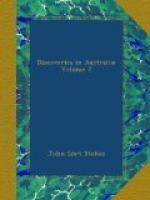May is the month in which the winter weather fairly sets in, and it rarely happens that the middle of this month passes without the rains having commenced. This season seems to vary but little as to the time and manner of setting in—it is ushered in by blowing weather, from about North-North-East, the wind gradually veering round to the westward, as it increases in strength. The first of this weather usually lasts from a week to fourteen days; then comes an interval of fine weather, generally of a fortnight’s duration, and sometimes a month; after which the rains set in more constant, and the intervals of fine weather are shorter; this weather lasts until October, and at times throughout that month.
During the intervals of fine weather the climate is delightful, and the country has a fresh and pleasing appearance; land and seabreezes are as regular as in summer, with the exception, that the latter are much more moderate.
The North-West gales that occasionally occur during the winter months, on the southern parts of the west coast of Australia, are probably felt as far north as Shark’s Bay. They blow with great violence, and are accompanied by dark, gloomy weather, and rain. It is then unsafe to be near the land—as the gale that commences at North-North-East, invariably veers to the westward, making a lee shore of the whole line of coast, and between West-North-West and West-South-West blows the hardest.
Fortunately these gales give ample warning; the barometer always foretells their approach, and generally begins to fall three or four days before the commencement of the gale—besides which, there are other never-failing indications of a northerly wind, such as, the change of the current, which (owing to the prevailing southerly winds) usually sets to the northward, but runs strong to the southward during northerly winds—frequently preceding them, and giving more timely notice than the barometer.
A rising of the water is likewise a certain prognostic of a northerly wind; and has been invariably noticed, at Swan River, to precede all gales from that quarter—this, of course, can only be observed while at anchor on the coast.
Another, and perhaps equally certain sign of approaching bad weather, during the winter season (and which is almost certain to be from the northward) is the strength of the North-East winds—as it has been observed, that when the land winds blow strong, particularly from the North-East and the seabreezes are light, with a falling barometer, a gale from the northward will follow. Perhaps these latter remarks, are only applicable to that distance from the shore, where a ship will be within the influence of the land and seabreezes; but as I conceive the limit of that distance to be full 30 miles off shore, a notice of such a symptom of approaching bad weather, may not be altogether useless. I am of opinion, that land winds are at times felt as far off shore as the edge of soundings, which is not less than 30 miles, and generally between that and 40.




